Based on the 2020 Census of Population and Housing (2020 CPH), Oriental Mindoro had a total population of 908,339 persons. Of this total, the household population comprised 99.8 percent or 906,661 persons.
Of the 906,661 household population in 2020, 458,903 (50.6 percent) were males while 447,758 (49.4 percent) were females. (Figure 1) By age group, 290,410
(32.0 percent) were under 15 years of ag e (young dependents). On the other hand, persons aged 15 to 64 years (working-age or economically-active population) totaled to 566,367 (62.5 percent) while those in age groups 65 years and over (old dependents) comprised the remaining 49,884 (5.5 percent). In 2015, persons aged 0 to 14 years, 15 to 64 years, and 65 years and over accounted for 34.8 percent, 60.5 percent, and 4.7 percent, respectively, of the household population.
Moreover, there were more males (92.5 percent) than females (90.2%) among the
0 to 59 age group. However, among the older age group (60 years and over), females (9.8 percent) outnumbered the males (7.5 percent). The same trend was also observed in 2015.
Figure 1. Percent Distribution of Population by Sex, Oriental Mindoro: 2020
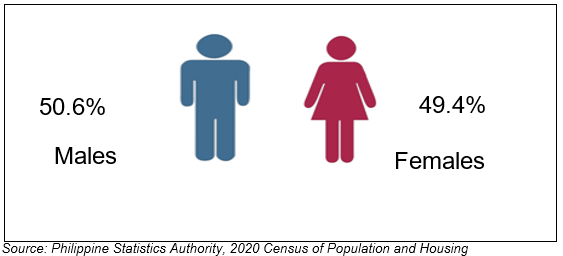
Figure 2. Age-Sex Pyramid of Household Population, Oriental Mindoro: 2020
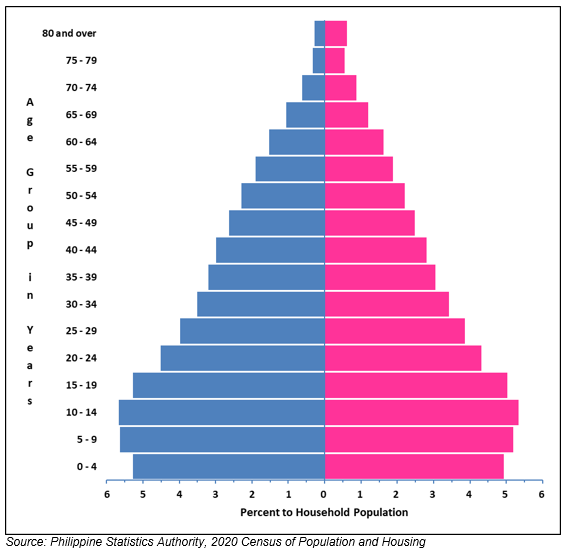
Sex ratio stands at 102 males per 100 females
The sex ratio in Oriental Mindoro was computed at 102 in 2020. This means that there were 102 males for every 100 females. The sex ratio in 2015 was slightly higher at 103 males per 100 females.
In 2020, children aged below 15 years had a sex ratio of 107 males per 100 females, while those aged 15 to 64 years had a sex ratio of 104 males per 100 females. Moreover, among those aged 65 years and over, the sex ratio was 70 males per 100 females. This depicts a longer life expectancy among females than males or a higher mortality rate among males than females in the older age groups.
Figure 3. Sex Ratio of Household Population by Selected Age Group, Oriental Mindoro: 2020
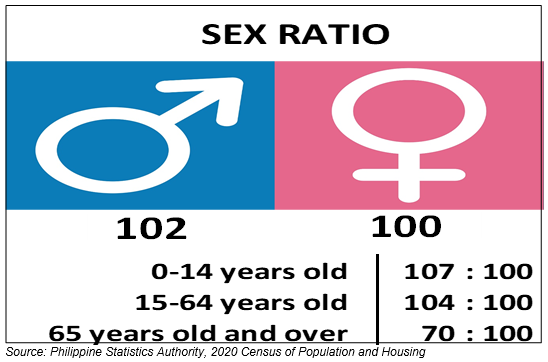
Dependency ratio declines to 60 dependents per 100 persons in the working-age group
The overall dependency ratio of Oriental Mindoro was computed at 60, which indicates that for every 100 working-age or economically-active population, there were about 60 dependents (51 young dependents and 9 old dependents). This is slightly lower than the dependency ratio in 2015, which was recorded at 61 dependents per 100 working-age population (53 young dependents and 7 old dependents). share), resulting in a sex ratio at birth of 110 males per 100 females.
Table 1. Age dependency Ratio of the Household Population by Sex, Oriental Mindoro: 2020 and 2015
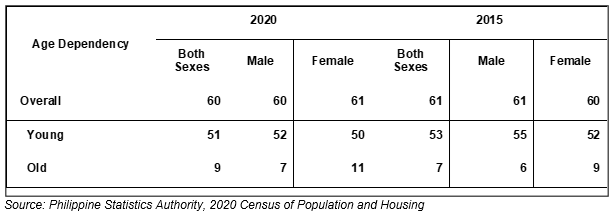
Vital Statistics
Registered live births in the province of Oriental Mindoro decreased by 8.7 percent from 13,949 births in 2017 to 12,735 births in 2023. A slight increase of 0.6 percent was observed in 2023 compared to the 12, 664 registered live births in 2022. The crude birth rate in the province was registered at 13.7 or approximately 14 births per thousand population. On the average, 1,061.3 or 1061 babies were born monthly in the province or 34.9 or 35 babies were born daily, which translates to 1.5 or two babies per hour. In 2023, more males (6,657 or 52.3 percent share) were born than females (6,078 or 47.7 percent).
Figure 4. Percent Share of Registered Live Births by Sex, Oriental Mindoro: 2023
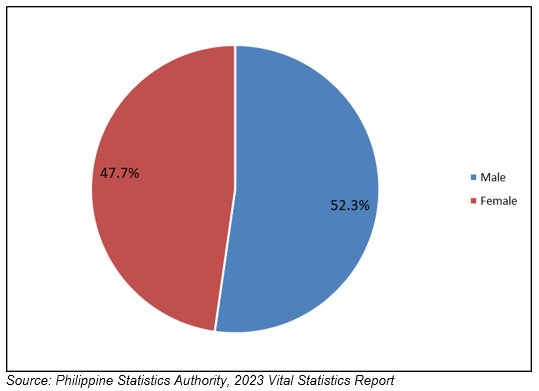
On deaths statistics, the province of Oriental Mindoro reported 5,757 deaths in the year 2023, which exhibits a slight increase of 0.2 percent from 5,745 registered deaths in 2022. This is equivalent to crude death rate of 6.2 or six deaths per 1,000 population. On the average, this corresponds to an average of 16 deaths per day.The age-sex structures of registered deaths in 2023 shows an inverted pyramid, with fewer deaths at younger ages, except for children belonging to age group 1-4 and under one, and gradually increasing as people grow older. In Oriental Mindoro the number of male deaths (3,285 deaths or 57.1 percent share) was higher than female deaths (2,472 deaths or 42.9 percent share). The proportion of males who died was highest at the age of 65 to 69 years old (406 deaths or 12.4 percent share), followed by age group 70 to 74 years old (388 deaths or 11.8 percent share), then by age group 60 to 64 years old (365 deaths or 11.1 percent share) while for females, the largest was at the age group of 85 years old and over (416 deaths or 16.8 percent share), followed by age group 70 to 74 years old (281 deaths or 11.4 percent share) and then by age group 80 to 84 years old (271 deaths or 11.0 percent share). (Figure 5)
Figure 5. Percent Share of Registered Deaths by Age and Sex, Oriental Mindoro: 2023
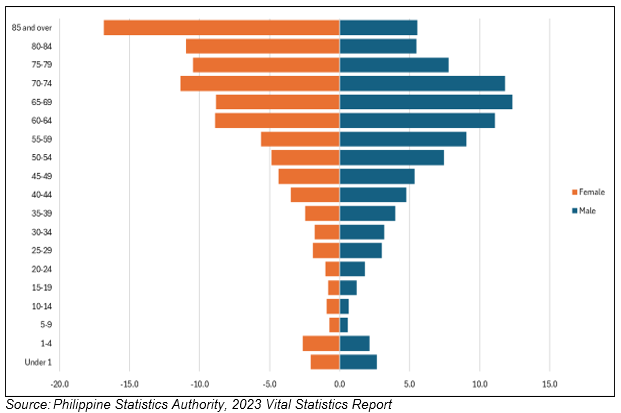
On marriage statistics, the province of Oriental Mindoro registered 3,888 marriages in 2023, 9.4 percent decrease compared to registered marriages in 2022 with 4,289. The crude marriage rate in the province decreased to 4.2 marriages per thousand population from 4.7 marriages per thousand population in 2022. The average daily marriages solemnized in Oriental Mindoro is 10.7 or 11 marriages. Of the total number of registered in the province, around four in ten men, 1,405 registered marriages or 36.1 percent share, married at aged 25 to 29. Same proportion was seen for women, 1,419 registered marriages or 36.5 percent share. The number of men with registered marriages who are over 50 years of age (142 or 3.7 percent share) was twice than the number of women of the same group (72 or 1.9 percent share). Moreover, a total of 1,170 marriages or 30.1 percent share involved marriages on adolescent females below 20 years old while the number of marriages involving adolescent males recorded 724 marriages or 18.6 percent share. (Figure 6)
Figure 6. Percent Distribution of Registered Marriages by Age Group and Sex, Oriental Mindoro: 2023

(SGD) CHARLYN ROMERO-CANTOS, PhD
(Chief Administrative Officer)
Officer-in-Charge
Oriental Mindoro Provincial Statistical Office
Technical Notes on Vital Statistics
2020 Census of Population and Housing
Definition of Terms
Population Census refers to the systematic process of gathering, analyzing, and publishing demographic, economic, and social data for all individuals within a specified territory.
Total Population refers to the aggregate of household and institutional populations, including Filipino nationals residing in Philippine embassies, consulates, and missions abroad.
Household Population consists of individuals belong to the household, the basic criterion of which is the usual place of residence or the place where the person usually resides.
Household is a social unit comprising either a single individual or a group of individuals residing in the same housing unit, sleeping and sharing common food preparation and consumption arrangements.
Sex ratio is the ratio of males to females in a given population, expressed as the number of males per 100 females.
Introduction on Vital Statistics
Vital statistics are derived from information obtained at the time when the occurrences of vital events and their characteristics are inscribed in a civil register.
Vital acts and events are the births, deaths, fetal deaths, marriages, and all such events that have something to do with an individual's entrance and departure from life together with the changes in civil status that may occur to a person during his lifetime. Recording of these events in the civil register is known as vital or civil registration and the resulting documents are called vital records.
STRUCTURE OF VITAL STATISTICS SYSTEM
The production of vital statistics comprised of a system of operations in which the registration of vital events is an important component. The system begins with the registration followed by the processing and controlling of vital records and ends with the compilation and analysis of vital statistics.
Under Commonwealth Act (CA) 591, the Bureau of Census (now Philippine Statistics Authority) is mandated to generate general purpose statistics and to carry out and administer Act No. 3753.
Under the same law, the head of the PSA is also the Civil Registrar General (CRG) who directs and supervises the local civil registration activities in the country. The CRG in this regard is empowered to prepare and issue implementing rules and regulations on civil registration and to prepare and order printed the necessary forms for proper compliance.
The set-up of vital statistics system involves different entities and cuts across different departments and personalities.
For the registration of vital events, the Local Civil Registry Offices (LCROs), which are the registration units in the country and headed by the City/Municipal Civil Registrars (C/MCRs), are under the Local Government Units (LGUs). The hospitals, clinics, rural health units and similar institutions including barangay secretaries, practicing physicians, midwives, nurses, traditional midwives, solemnizing officers from various religious sects and denomination are required to assist in the reporting of vital events for registration at the LCROs. The concerned parents, next of kin, contracting parties, a witness or the person who has full knowledge of the occurrence of the event are also required to report the event, in default of the first mentioned set of informants.
The processing and controlling of vital documents are done at the LCROs and at the PSA Provincial and Central Offices.
The compilation and analysis of vital statistics is taken cared of by the PSA Central Office under the Vital Statistics Division of the Civil Registration and Central Support Office.
THE REGISTRATION METHOD
As mandated in Act 3753, all vital events that marked the entry and departure of a person in his lifetime and the changes in his/her civil status shall be registered. The registration method is defined as the continuous, permanents and compulsory recording of the occurrences and characteristics of vital events, primarily for their value as legal documents and secondary for their usefulness as a source of statistics.
Place where to register the event
As a general rule, the place of registration is the LCRO of the city of municipality where the vital events occur.
Out of town reporting of vital event occurs when the documents presented to the civil registrar of LCRO, which is not the place of occurrence, not for registration but to be forwarded to the civil registrar of LCRO where the event occurred and where it should be registered.
Forms to use
The civil register consists of certificates and the registry book. It also includes the actual copies of the registrable court decisions and the legal instruments concerning the civil status of persons. The certificates are loose-leaf forms in a set of four copies except for the Certificate of Foundling which is in a set of three.
Person who will report the event
The informant is the one who reports the event for registration and who gives information to be recorded in the civil register.
For death occurrences, the report shall be made by the hospital or clinic administrator if the person dies in the hospital or clinic, or by attending physician or by the nearest relative or by any interested party who has knowledge of the occurrence of death. In all cases, the report shall be submitted to the Local Health Officer (LHO) who shall direct and order the C/MCR to enter the death in the civil register.
Period when to report the event
Death or fetal death shall be reported to LHO within forty eight (48) hours from the time of death and the LHO shall direct or cause the registration to the C/MCR not later than thirty (30) days from date of death.
Any report made to the LCROs beyond the reglementary period are considered late and can be entered only in the civil register after the informant complies with the requirements for delayed registration.
Operative Act of Registration
The C/MCR sees to it that appropriate form it used; form is properly and completely filled-up; and proper attachments are submitted. In case, the entries are found incomplete, the C/MCR has to require the person concerned to fill up the document completely or to correct the entries.
When the document is accepted for registration, the date of receipt is recorded in the space provided and the documents received for the day are entered immediately in the appropriate civil registry book, assigning therein the corresponding registry number. After registration entry/entries found erroneous can only be corrected through RA 9048, except sex, nationality, age and status which require court approval.
Distribution of registered documents
Upon registration, the C/MCR distributes the copies accordingly: the first copy to the informant; the second copy to the CRG; the third copy shall be retained by the LCRO; and the fourth copy to the attendant or solemnizing officer, as the case may be. The CRG copy is the source of vital statistics published in this report.
DEFINITION OF TERMS AND CONCEPTS
Significant terminologist and descriptions in the foregoing highlights and tables are defined below. Included are some items found in the certificates and summary measure used in describing the facts of events.
Death refers to the permanent disappearance of all evidence of life at any time after live birth has taken place (postnatal cessation of vital function without capability of resuscitation).
Crude Death Rate (CDR) refers to the number of deaths per 1,000 mid-year population.
Daily Average refers to the arithmetic mean of birth, death or marriage occurrences per day.
Daily Index is the increase/decrease from the overall daily average of event occurrences.
Usual Residence refers to the place where the person habitually or permanently resides.
Place of Occurrence refers to the place where the vital event took place.

